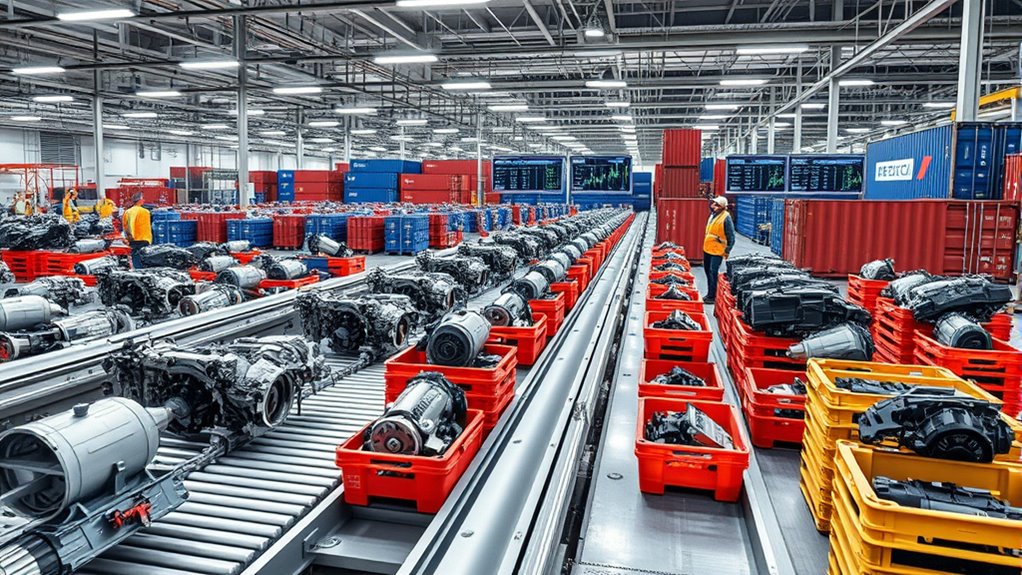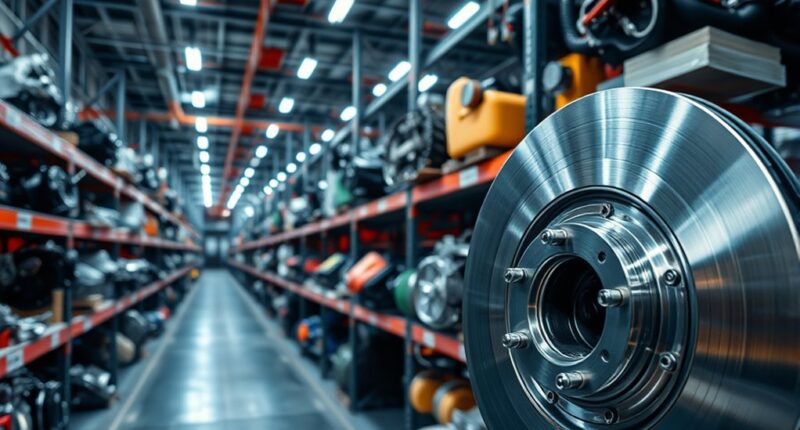Starting in 2025, a 25% tariff on auto parts will raise costs for manufacturers, leading to higher prices for vehicles and repairs that you’ll likely pay for. This tax disrupts supply chains, causing delays and shortages as companies seek alternatives. Manufacturers may also shift to domestic production, which takes time and increases expenses. If you want to understand how these changes could impact your car ownership and costs, keep exploring further.
Key Takeaways
- The 25% tariff increases import costs for auto parts, leading to higher prices for consumers and manufacturers starting in 2025.
- Supply chains may experience disruptions, delays, and shortages as importing auto parts becomes more expensive.
- Automakers might redesign parts or shift to domestic production to offset tariff impacts.
- Consumers could face increased costs for vehicle repairs, maintenance, and new vehicle purchases.
- The industry may adapt by restructuring supply chains and investing in sustainable, domestic manufacturing options.

Starting in 2025, a 25% tariff will be imposed on imported auto parts, impacting manufacturers, consumers, and the automotive industry as a whole. If you’re involved in the auto parts supply chain, you’ll quickly notice how this tariff disrupts the flow of goods. The increased costs won’t stay isolated; they ripple through the entire supply chain, causing delays and uncertainties. For manufacturers, this means higher manufacturing costs as they face steeper expenses for imported components. These costs often get passed down the line, resulting in more expensive vehicles and parts for consumers. As a result, you might see a rise in the prices of new cars, repairs, and replacement parts, which could strain your budget or influence your purchasing decisions.
The supply chain impacts are particularly significant because auto parts are often sourced globally, with different countries specializing in specific components. When tariffs increase, it becomes more expensive to import these parts, forcing manufacturers to adjust their sourcing strategies. Some may look for alternative suppliers or try to produce more parts domestically, but these options come with their own costs and challenges. Short-term, you may notice delays or shortages of certain auto parts as companies scramble to adapt, which can lead to longer wait times for repairs or new vehicle deliveries.
Manufacturing costs are directly affected because tariffs add an extra layer of expense to the production process. You might not see these costs immediately reflected in the price of parts or vehicles, but over time, they will likely lead to higher prices overall. Manufacturers may also be compelled to redesign or modify parts to avoid tariffs, which can increase development costs further. These increased expenses might reduce profit margins for manufacturers, pushing them to find efficiencies elsewhere—or pass the costs onto consumers. If you’re a consumer, this means paying more for vehicles, replacement parts, or repairs, which can impact your budget and vehicle maintenance plans. Additionally, some automakers are exploring sustainable and eco-friendly manufacturing practices to mitigate future tariff impacts.
In the long run, the tariff could also influence industry dynamics, prompting automakers to reconsider their supply chain configurations and manufacturing locations. While some may invest more in domestic production to mitigate tariff impacts, this transition isn’t immediate or cheap. Overall, you should prepare for a period of adjustment, where supply chain disruptions and rising manufacturing costs reshape the auto industry landscape, ultimately affecting your access to affordable auto parts and vehicles starting in 2025.
Frequently Asked Questions
Will Existing Auto Parts Tariffs Change Before 2025?
You might see changes in auto parts tariffs before 2025 due to ongoing trade negotiations and policy adjustments. Officials could modify existing tariffs to reach new agreements or respond to economic shifts. Stay informed about announcements from trade authorities, as these negotiations often influence tariff rates. Being proactive helps you anticipate potential cost changes and plan accordingly, ensuring you’re prepared for any updates before the 25% tariff officially takes effect.
How Will the Tariff Impact Used Auto Parts?
Imagine walking into a shop and seeing used auto parts priced higher than before, as the 25% tariff adds extra costs. This increases your expense for used parts, prompting sellers to adjust their pricing strategies. You might notice fewer options or higher prices, affecting your repair decisions. The tariff’s impact on used auto parts makes it essential for you to shop wisely, considering the new costs and potential alternatives.
Are There Exemptions for Certain Auto Parts?
Yes, there are auto parts exemptions and tariff exclusions. You might qualify if the auto parts are for specific uses like research, manufacturing, or emergency repairs. Customs officials evaluate requests for tariff exclusions on a case-by-case basis, so you should check the official guidelines and submit applications if your auto parts fall into these categories. Staying informed guarantees you can navigate exemptions effectively and minimize costs.
How Will the Tariff Affect Global Auto Manufacturing?
Imagine a tightly wound clock, each gear representing international trade and supply chains. The 25% auto parts tariff will slow down global auto manufacturing by increasing costs and disrupting production lines. Countries may shift sourcing strategies, causing delays and reshaping the industry landscape. You’ll see higher prices and potential shortages as manufacturers navigate these new trade tensions, altering how the auto world spins on its axis.
What Legal Challenges Might Delay the Tariff Implementation?
You might face legal challenges or trade negotiations that could delay the tariff implementation. Legal disputes often arise over trade policies, especially when affected parties contest the tariffs’ legality or fairness. These disputes can lead to court rulings or international negotiations that postpone or modify the planned tariffs. Stay informed about ongoing legal processes and trade talks, as they could notably impact when and how the tariffs are enforced.
Conclusion
By 2025, that 25% tariff could raise auto parts prices by up to $500 per vehicle, impacting your budget. This change influences not just your wallet but also the auto industry’s future. Keep an eye on how manufacturers and consumers adapt—history shows tariffs can shift markets quickly. Staying informed helps you make smart choices, so don’t ignore these shifts—they could profoundly shape your driving experience in the years ahead.










